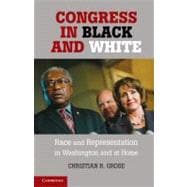
Note: Supplemental materials are not guaranteed with Rental or Used book purchases.
Purchase Benefits
What is included with this book?
| List of Figures and Tables | p. viii |
| Acknowledgments | p. xi |
| African-American Legislators, African-American Districts, or Democrats? | p. 1 |
| Summary of Book's Argument and Findings | p. 8 |
| The Book's Roadmap | p. 11 |
| A Unified Theory of African-American Representation in Congress | p. 14 |
| The Unified Theory of African-American Representation in Congress | p. 17 |
| Three Competing Theories of Racial Representation in Congress | p. 18 |
| Racial Trust between Black Voters and Black Legislators | p. 21 |
| Congressional Decision Making, Political Parties, and Race | p. 24 |
| Electoral Coalitions, Turnout, and Substantive Representation | p. 29 |
| Black Faces, White Districts: The Supreme Court and Racial Redistricting | p. 37 |
| White Legislators and Black-Influence Districts | p. 48 |
| Why No One Has Examined Both a Legislator's Race and a District's Black Population | p. 49 |
| The ôHollow Hopeö of Civil Rights Change in the U.S. House | p. 54 |
| Perverse Effects, Beneficial Effects, or Minimal Effects? Does Racial Gerrymandering Affect Median Civil Rights Policy Outcomes in the U.S. House? | p. 58 |
| What Are Black Interests on Roll Calls? | p. 62 |
| How Can We Determine Legislators' Preferences on Civil Rights? | p. 64 |
| Has the Civil Rights Policy Space in Congress Changed Over Time? | p. 66 |
| The Relative Unimportance of the South for Civil Rights Floor Outcomes in the House | p. 68 |
| Civil Rights Ideological Shifts in State Delegations Due to Racial Redistricting | p. 71 |
| Political Parties, Agenda Setting, and Civil Rights Voting Records in Congress | p. 74 |
| Counterfactual Analysis | p. 76 |
| Did the Creation of Black-Majority Districts in 1992 Give the House to Republicans? | p. 78 |
| Summary: Racial Redistricting in 1992 and Aggregate Policy Outcomes in the U.S. House | p. 81 |
| What About at the District Level? Does Party or Race Matter More? | p. 82 |
| Implications for the Future of Majority-Minority Districts | p. 84 |
| Location, Location, Location: Delivering Constituency Service to African Americans | p. 87 |
| Constituency Service as Substantive Representation | p. 89 |
| The Importance of Race: Helping Constituents in the District | p. 90 |
| Talking with Congressional Staff to Assess Constituency Service to African Americans | p. 91 |
| Reaching Voters with Service: Race Trumps Geography and Party | p. 96 |
| Randy Forbes: ôBig Shoes to Fillö | p. 97 |
| Earl Hilliard: ôHe Was Elected to Represent the People Hereö | p. 100 |
| Congressional Offices in Black Neighborhoods? | p. 104 |
| Constituency Service in the District: Connecting Black Legislators, Black Staff, and Black Voters | p. 110 |
| African-American Staff and Substantive Congressional Representation | p. 111 |
| White Staff and Substantive Representation via Constituency Service | p. 115 |
| The Racial Backgrounds of Congressional District Staff Across the United States | p. 119 |
| Which Members of Congress Disproportionately Hire African-American Staff? | p. 122 |
| Commonality versus Difference: No Difference | p. 127 |
| Conclusion: Race and the Quality of Constituency Service to Black Constituents | p. 131 |
| Bringing Home the Bacon: Delivering Federal ôPorkö to African Americans | p. 134 |
| Pork Is Substantive Representation | p. 138 |
| Bringing Home the Bacon to Predominately Black Counties and Historically Black Colleges and Universities | p. 139 |
| Black Legislators Deliver More Projects to African Americans | p. 150 |
| The Effect of a Legislator's Race on Project Allocations | p. 151 |
| The Effect of Party on Project Allocation to Black Constituents | p. 153 |
| Racial Trust: The Interactive Effect of District Black Population and a Legislator's Race | p. 155 |
| Pork Delivery, Electoral Coalitions, and Racial Representation | p. 159 |
| Conclusion and Discussion | p. 165 |
| The Future of Racial Redistricting: Black-Decisive Districts | p. 167 |
| Race, Legislative Representation, and the Importance of Elections | p. 168 |
| The Need for Black-Decisive Districts: Policy Implications for the Future of Majority-Minority Districts and Representation | p. 172 |
| Criteria for Drawing Districting Plans Maximizing Black-Decisive Districts | p. 178 |
| Conclusion and Closing Thoughts | p. 183 |
| Methods Used to Measure the Civil Rights Issue Space | p. 187 |
| Methods for Qualitative Research | p. 193 |
| Data, Methods, and Models for Project Allocations to African Americans | p. 197 |
| References | p. 215 |
| Index | p. 231 |
| Table of Contents provided by Ingram. All Rights Reserved. |
The New copy of this book will include any supplemental materials advertised. Please check the title of the book to determine if it should include any access cards, study guides, lab manuals, CDs, etc.
The Used, Rental and eBook copies of this book are not guaranteed to include any supplemental materials. Typically, only the book itself is included. This is true even if the title states it includes any access cards, study guides, lab manuals, CDs, etc.